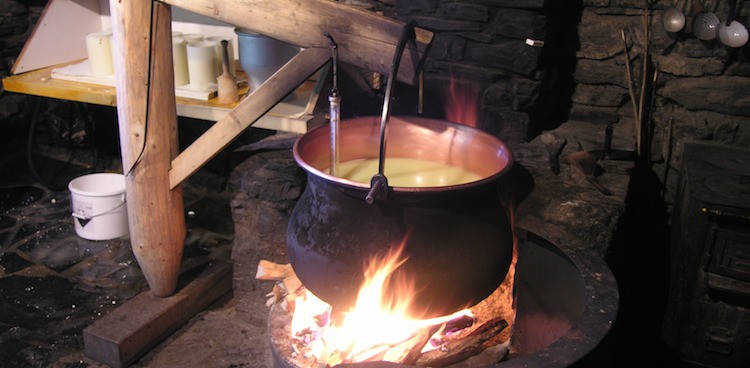
“In the English-speaking world, our approach to making cheese for most of the last 60 years has been like a Texas gunslinger’s: kill bacteria, ask questions later. If it’s not pasteurized, it’s dangerous, the thinking goes.” So starts an article on NPR’s The Salt about French raw milk cheeses.
This topic has been burbling away in the background of American food policy for years, with angry bubbles surfacing into the public eye occasionally (as with the FDA banning cheesemakers from aging their cheeses on wooden boards in the summer of 2014). Proponents of raw milk cheeses say that the naturally occurring cultures in raw milk improve the flavor and texture of cheese and that the delicate flavors from the grasses and flowers milk-producing animals may have grazed on are lost when milk is heated to pasteurizing temperatures. Opponents of raw milk cheeses site illnesses caused by outbreaks of harmful bacteria such as L. monocytogenes (Listeria) and E. coli, which they claim will flourish in the nutrient-rich environment of unpasteurized milk.
In a session at the 2014 American Cheese Society Conference in Sacramento, Calif., Jeremy Stephenson of Spring Brook Farm and Alexandre Pellicier of Alexandre Pellicier Cheesemaking Consulting discussed the differences between the American attitude towards bacterial cultures in cheesemaking versus that of France. To summarize the long and involved discussion, American cheesemakers start with a completely sterile environment and work very hard to keep all equipment for cheesemaking and aging free of microbes. The French, on the other hand, encourage microbiomes of “good” bacteria to compete with and outgrow bad bacteria before their presence can cause illness.
The French system of using good bacteria to battle bad is more complex than you might imagine and starts long before the milk enters the make room. As Pellicier pointed out during his talk, the food the milk producing animals eat is also important. For the Alpine Beaufort made in his native France, the cows are required to stay away from silage, fermented foods, and beet pulp. Why? Because these food sources are rich in bacteria that survive through the cheesemaking process and into the cheeses, causing lower-quality flavors and excess carbon dioxide production that will “blow out” the cheese.
But if the strict guidelines for French raw milk cheese production are followed, it seems that the results are more than encouraging. A study conducted in 2001 by Marie-Amélie Chopard on Emmentaler cheese showed that materials that were cleaned and dried, but not sterilized ended up with significantly less Listeria growth than materials that were cleaned, dried and sterilized (a follow-up study using Reblochon supported this result). The reason? “Sanitation creates empty spaces. The wood surface is colonized by lactic bacteria and by the microflora of the cheese rind. This living biofilm… inhibits the growth of Listeria monocytogenes.”
American researchers are also beginning to explore the world of cheese microbiology and how it affects both flavor and food safety. Scientists Rachel Dutton and Benjamin Wolfe work at Harvard’s FAS Center for Systems Biology studying microbial community formation in cheeses. They work is dedicated not to isolating the microbes that flourish on and in cheeses but to understanding how these microbes work together as a communal micro ecosystem. One of their recent papers, published in Cell, focused on the positive and negative interactions between these community members.
All this is to say that killing bacteria first and asking questions later might not be the best approach for American cheesemakers. Instead, it might be worth looking at how French cheesemakers encourage friendly bacteria to colonize their cheeses and work spaces, squeezing out negative interlopers that cause illness or even just bad flavors.
Photo Credit: Image courtesy of Wikimedia.org




I’m not a cheese specialist, nor a microbiologist, but I have done a lot of reading on various people’s and the cheeses they make. I have a small herd of Nubian dairy goats and have been making raw milk cheeses for 10+ years. YUM!!
Is there an english translation of the studies linked? if so, where might I find to read it. thanks.
I am Ayrshire milk producer with 20 cows in Bogota, Colombia. I would to get The knowledge to create best cheesse with raw milk.
As a cheese specialist , I am happy to get educated and informed from Culture !!! Always the best !!
Thank you !!
Georgia Lonchar
Cheese specialist
Kowalski’s Market Eagan